RDP 9301: The Response of Australian Stock, Foreign Exchange and Bond Markets to Foreign Asset Returns and Volatilities 4. Bond Yield Volatilities and Correlations
March 1993
- Download the Paper 128KB
Figures 16 through 20 picture the long-term government bond yields and the estimated Schwert volatility indices for five countries: Australia, Germany, Japan, the United Kingdom, and the United States. The Australian bond yield is the yield on 10 year Treasury bonds; the German yield is the public sector yield on 7–15 year bonds; the Japanese yield is the central government bond yield; the UK rate is the 10 year government security yield; and the US yield is the government security yield for bonds of 10 years or more[13].
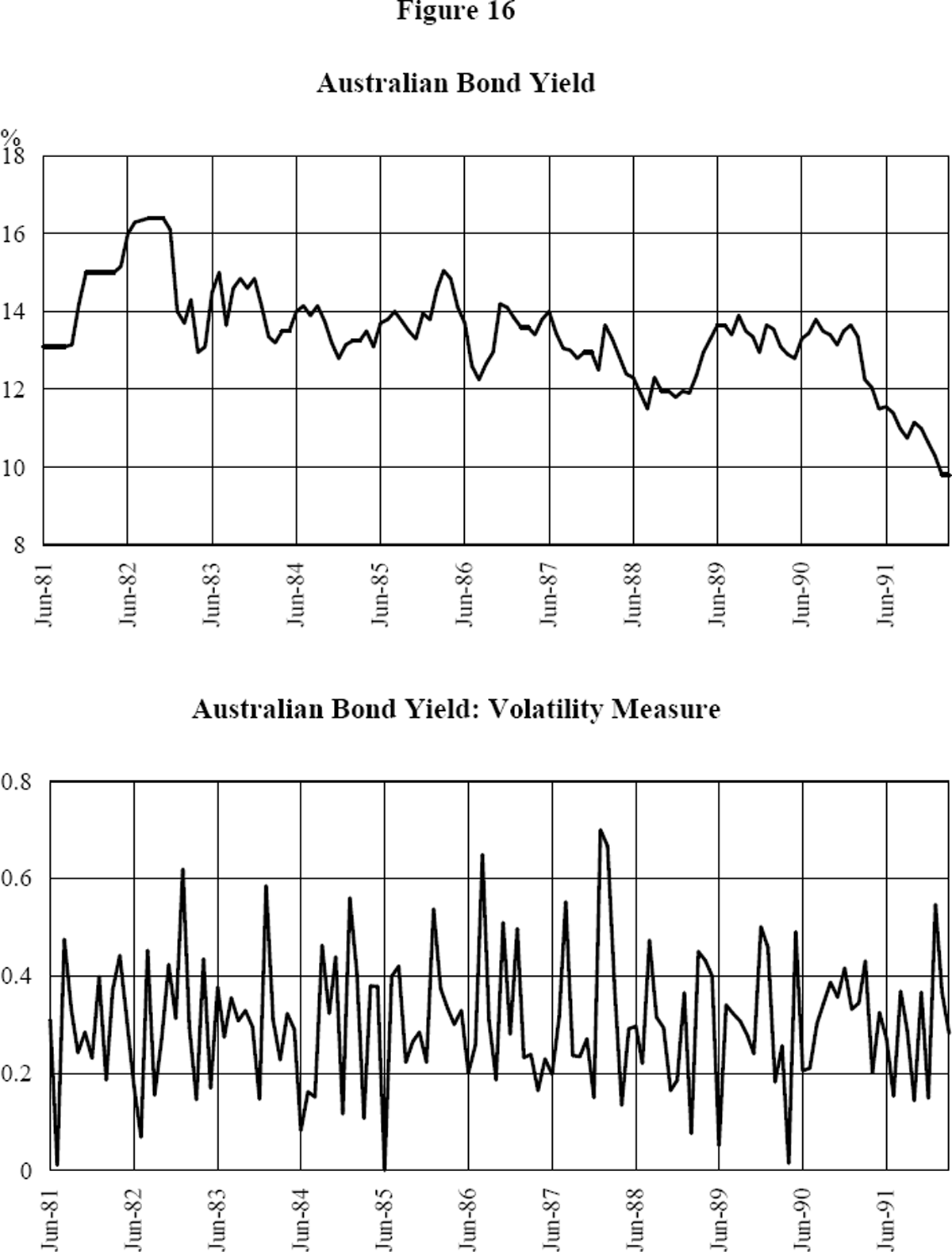
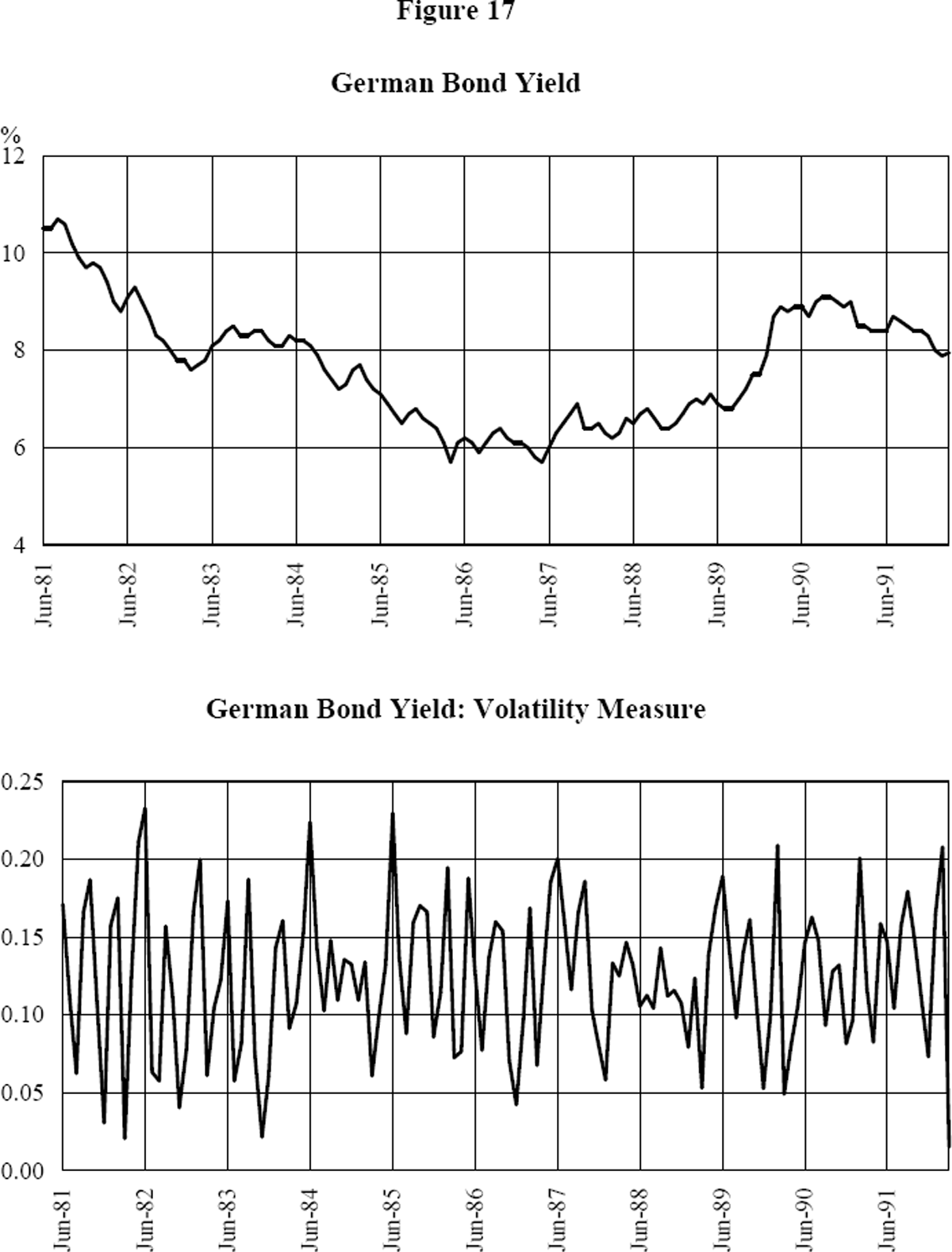
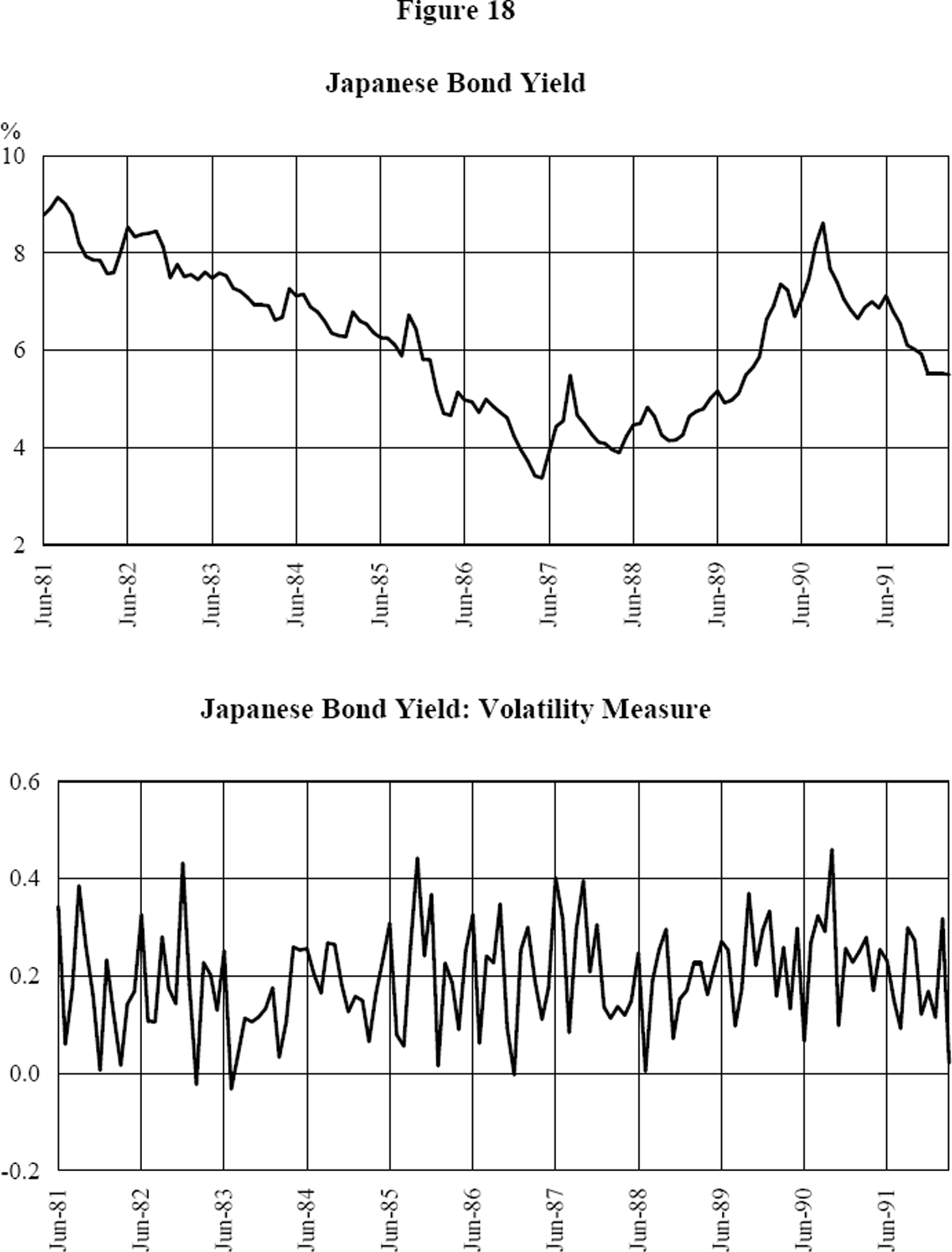
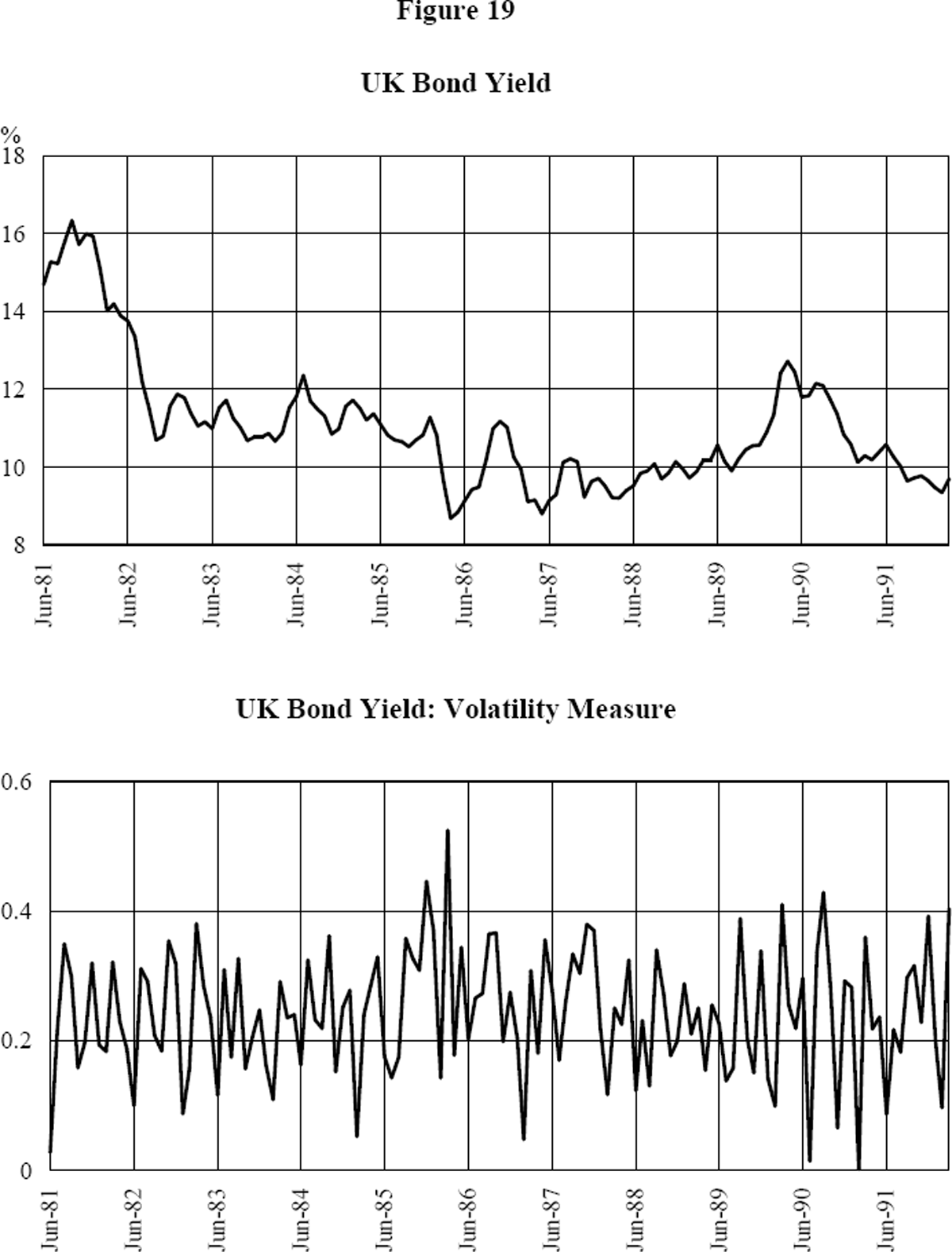
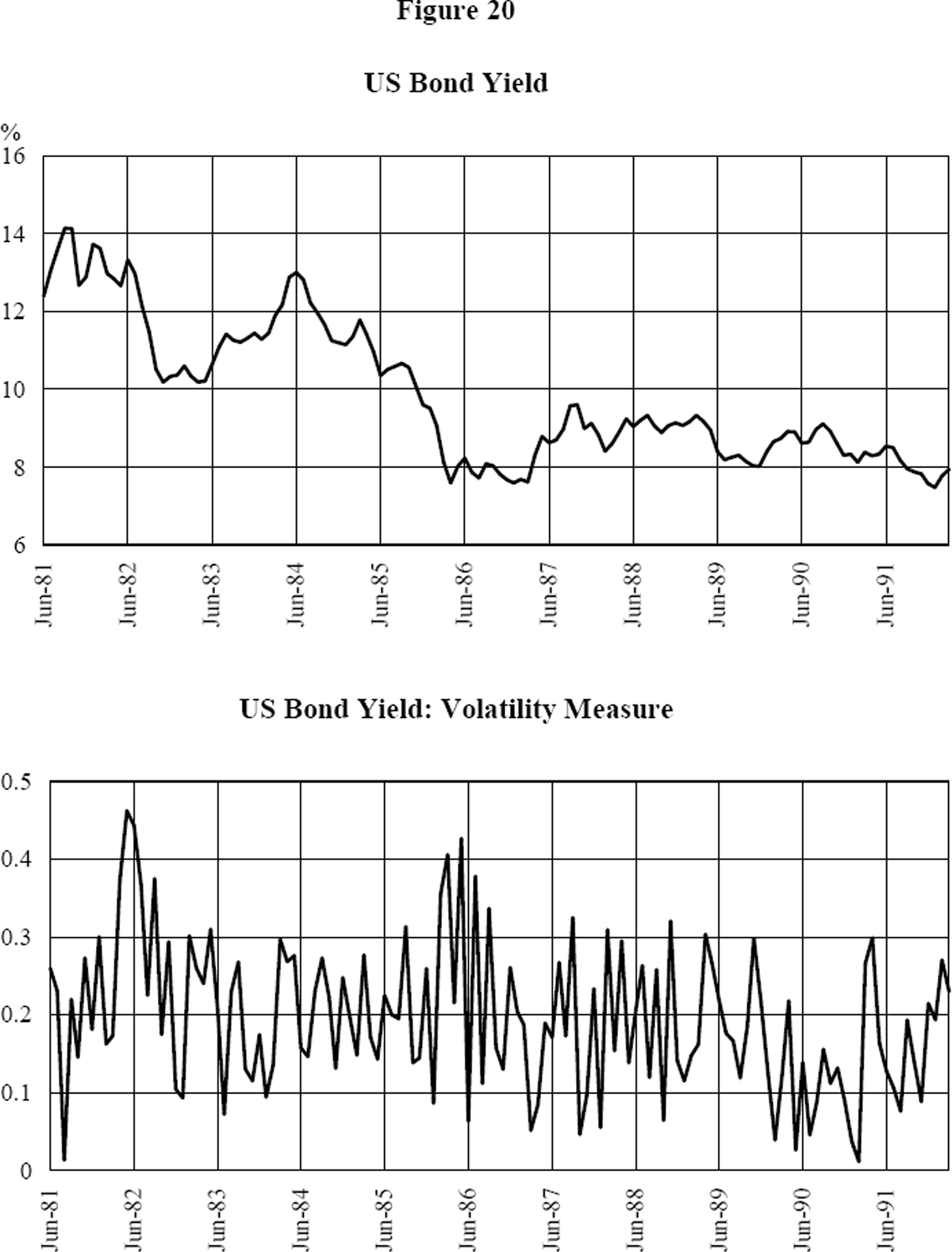
Figure 16 shows that the Australian bond yield declined by about six percentage points over the course of the decade, with the greatest decline coming during the past two years. The volatility measure appears to be centred on a mean of 0.3.
The German bond yield shows a steeper decline during the first half of the decade, with a reversal and upward movement in the mid-1980s. The volatility measure for the German yield in Figure 17 shows no obvious trend, and appears to be centred on a mean of 0.12.
The pattern of the Japanese long-term bond yield is similar to that of the German yield, with a decline and then a reversal in the mid-1980s, and with no obvious trend in the volatility index. The index is centred on a mean value of 0.2.
The UK bond yield declined rapidly at the start of the decade, and hovered close to a value of 10 percent until it increased by about two percentage points, temporarily. The volatility index appears to be centred on a value of 0.2.
The behaviour of the US long-term bond yield in Figure 20 shows two periods of sharp decline: one at the beginning of the decade, and another mid-way through the decade. From the mid-1980s, the yield hovers close to a value of 8 percent. The volatility measure for the United States, unlike the measure for the other countries, shows a decline. Its mean value falls from 0.2 to a value of 0.1 towards the end of the decade.
4.1. Contemporaneous Correlations
The contemporaneous correlations in the bond yield volatility measures appear in Table VII, Panel A. The results show negative correlations of the Australian volatility measure with the foreign bond yield volatility measures. The largest positive correlation is between the German and Japanese volatility measures.
| Aust | Germ | Japan | UK | US | |
|---|---|---|---|---|---|
| Aust | 1.00 | ||||
| Germ | −0.12 | 1.00 | |||
| Jap | −0.07 | 0.37 | 1.00 | ||
| UK | −0.11 | −0.36 | 0.10 | 1.00 | |
| US | −0.16 | 0.10 | −0.08 | 0.12 | 1.00 |
| Argument | Dependent Variable | ||||
|---|---|---|---|---|---|
| Australia | Germany | Japan | UK | US | |
| Australia | 3.77 | 7.48 | 1.17 | 2.95 | 7.07 |
| Germany | 5.85 | 4.17 | 2.11 | 5.60 | 3.37 |
| Japan | 1.17 | 1.44 | 1.17 | 2.85 | 6.95 |
| UK | 4.23 | 5.80 | 4.10 | 4.24 | 1.73 |
| US | 5.54 | 2.67 | 0.95 | 2.07 | 4.21 |
| Argument | Dependent Variable | ||||
|---|---|---|---|---|---|
| Australia | Germany | Japan | UK | US | |
| Australia | 98.6 | 2.0 | 7.14 | 34.9 | 59.8 |
| Germany | 184 | 101 | 1296 | 743 | 999.8 |
| Japan | 96.4 | 6.0 | 83.1 | 40 | 69.3 |
| UK | 256 | 12 | 220 | 101 | 113 |
| US | 211 | 5.7 | 138 | 67 | 101.3 |
4.2. Tests of Granger Causality
The Granger test of causality in Panels B and C of Table VII indicates that the most significant of all of the five bond yield volatilities is the German yield. The Wald statistics show that this measure is exogenous to the Australian bond-yield volatility as well as to the measures of the other bond-yield volatility measures.
4.3. Impulse Response Functions and Variance Decomposition
Figure 21 pictures the impulse response functions for unit shocks in the Australian bond yield volatility and the German bond yield volatility measures.
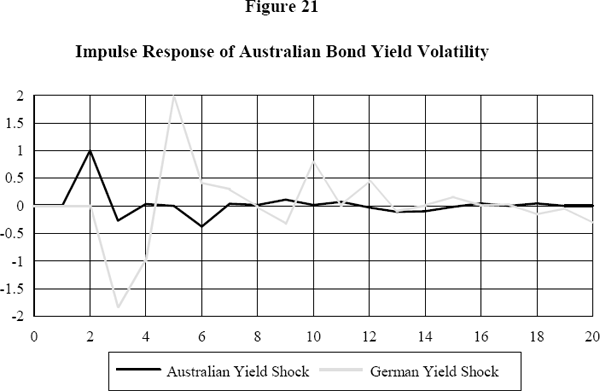
This figure shows that the shock in the German volatility outweighs the effect of a unit shock in Australian volatility, in both negative and positive directions. While the contemporaneous correlation coefficients and first-stage impulse-response path show a negative relation between Australian and German bond-market volatility, there is a strong positive reaction in Australian bond yield volatility in intermittent stages.
The variance-decomposition analysis of Table VIII further supports the strong influence of the German volatility measure for Australian bond yield volatility: within one quarter, shocks in this measure account for about 80 percent of the forecast errors of Australian bond volatility.
| Horizon | Percentage of Variance Due To: | ||||
|---|---|---|---|---|---|
| Australia | Germany | Japan | UK | US | |
| 1 | 24.08 | 74.83 | 0.07 | 0.03 | 0.99 |
| 5 | 11.89 | 81.92 | 0.55 | 2.50 | 3.14 |
| 10 | 10.88 | 80.94 | 0.92 | 3.38 | 3.88 |
| 15 | 10.75 | 80.40 | 1.27 | 3.34 | 4.24 |
| 20 | 10.63 | 80.38 | 1.40 | 3.38 | 4.20 |
| 40 | 10.60 | 80.37 | 1.42 | 3.40 | 4.20 |
| 60 | 10.60 | 80.37 | 1.42 | 3.40 | 4.20 |
4.4. Analysis of Time-Varying Bond Yield Coefficients
As in the analysis of the stock prices and exchange rates, I examine the following time-varying coefficient model:
where [ΔiGer,t ΔiJap,t ΔiUK,t ΔiUS,t]
is the matrix of first differences of the German (Ger), Japanese (Jap),
British (UK), and the United States (US) bond yields at time t, ΔiA,t
is the first difference of the Australian yield at time t, [ ] are the time-varying
coefficients of the contemporaneous foreign yields and lagged own yield, and
] are the time-varying
coefficients of the contemporaneous foreign yields and lagged own yield, and
 is a random variable, with independent
and identical distribution.
is a random variable, with independent
and identical distribution.
Figure 22 shows the time-paths of the time-varying yield coefficients with the German bond rate and the UK bond rate. The coefficient of the German yield becomes more strongly positive, and the coefficient of the UK rate more strongly negative from the beginning towards the middle of the past decade. However, both coefficients fall in absolute value towards the end of the decade.
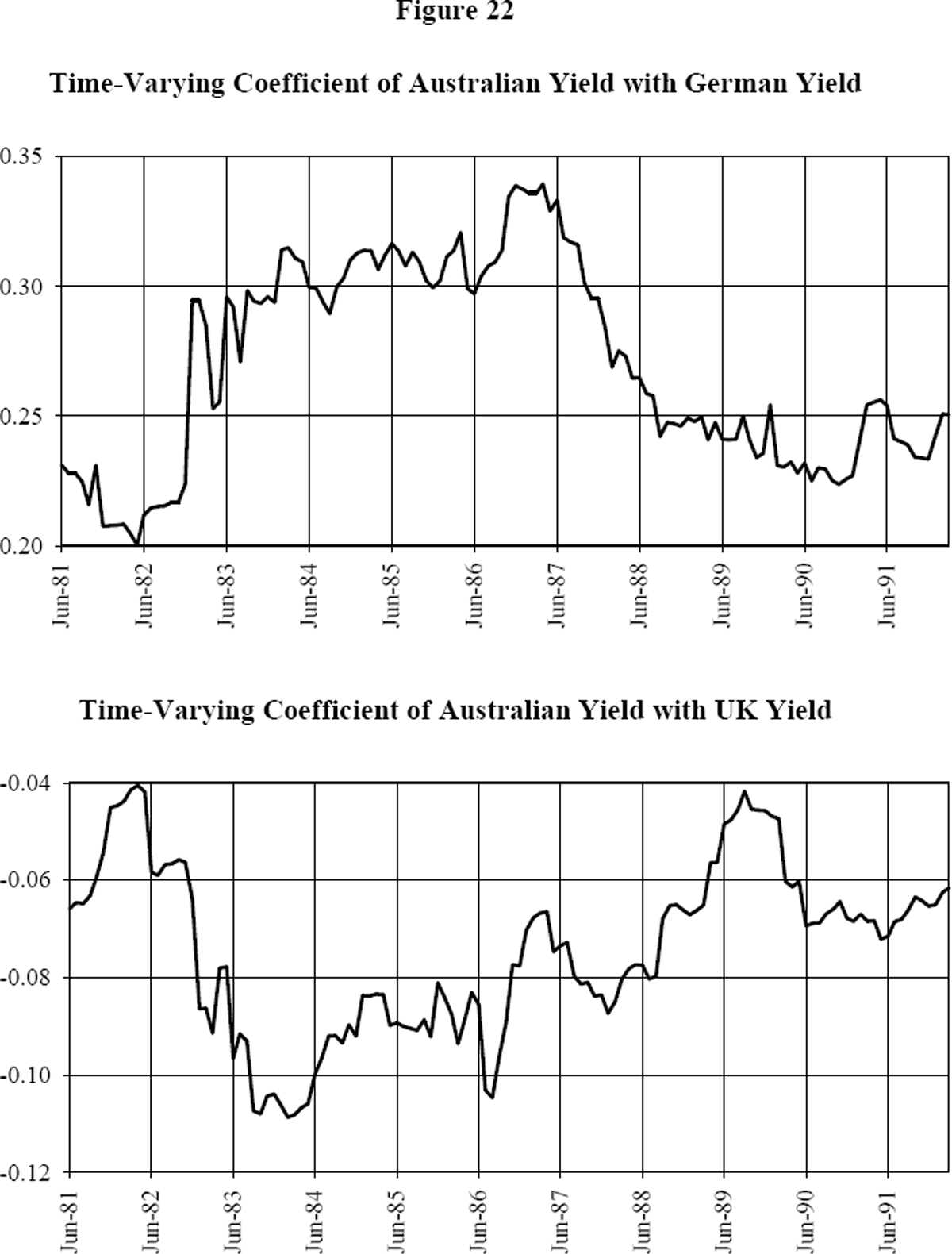
Table IX contains the correlation coefficients of these two time-varying coefficients with the volatility measures for the five bond yields. The table indicates very little degree of correlation of the time-varying coefficients with the volatility measures.
| Volatility Index: | Coefficients | |
|---|---|---|
| β*GER | β*GER | |
| Aust | −0.0568 | −0.0568 |
| Germ | −0.0154 | −0.0154 |
| Japan | 0.1076 | 0.1076 |
| UK | −0.0727 | −0.0727 |
| US | −0.0048 | −0.0048 |
The analysis suggests that the German market, if any market at all, has the most significance for the Australian bond market, for predicting both the yields themselves and their volatility through time.
Footnote
The bond yields come from Table F.11, ‘Overseas Interest Rates and Government Security Yields’, of the Reserve Bank of Australia Bulletin, various issues. [13]
